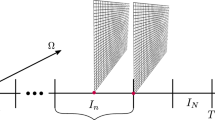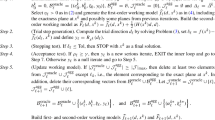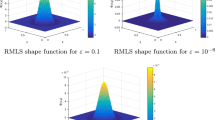Abstract
This paper deals with conforming high-order finite element discretizations of the vector-valued function space H(Div) in 2 and 3 dimensions. A new set of hierarchic basis functions on simplices with the following two main properties is introduced. When working with an affine, simplicial triangulation, first, the divergence of the basis functions is L 2-orthogonal, and secondly, the L 2-inner product of the interior basis functions is sparse with respect to the polynomial degree p. The construction relies on a tensor-product based construction with properly weighted Jacobi polynomials as well as an explicit splitting of the higher-order basis functions into solenoidal and non-solenoidal ones. The basis is suited for fast assembling strategies. The general proof of the sparsity result is done by the assistance of computer algebra software tools. Several numerical experiments document the proved sparsity patterns and practically achieved condition numbers for the parameter-dependent Div - Div problem. Even on curved elements a tremendous improvement in condition numbers is observed. The precomputed mass and stiffness matrix entries in general form are available online.
Similar content being viewed by others
References
Abramowitz, M., Stegun, I. (eds): Handbook of Mathematical Functions. Dover, NY (1965)
Ainsworth M., Coyle J.: Hierarchical finite element bases on unstructured tetrahedral meshes. Int. J. Numer. Methods Eng. 58(14), 2103–2130 (2003)
Andrews, G.E., Askey, R., Roy, R.: Special functions. In: Encyclopedia of Mathematics and its Applications, vol. 71. Cambridge University Press, Cambridge (1999)
Arnold, D.N., Falk, R.S., Winther, R.: Differential complexes and stability of finite element methods I: the de Rham complex. In: Arnold, D., Bochev, P., Lehoucq, R., Nicolaides, R., Shaskov, M. (eds.) Compatible Spatial Discretizations. The IMA Volumes in Mathematics and its Applications, vol. 142, pp. 23–46. Springer, Berlin (2006)
Babuška, I., Suri, M.: The p- and h-p versions of the finite element method, an overview. Comput. Methods Appl. Mech. Eng. 80(1–3), 5–26 (1990, spectral and high order methods for partial differential equations (Como, 1989))
Bećirović A., Paule P., Pillwein V., Riese A., Schneider C., Schöberl J.: Hypergeometric summation algorithms for high-order finite elements. Computing 78(3), 235–249 (2006)
Beuchler S., Pillwein V.: Shape functions for tetrahedral p-fem using integrated Jacobi polynomials. Computing 80, 345–375 (2007)
Beuchler, S., Pillwein, V.: Completions to sparse shape functions for triangular and tetrahedral p-fem. In: Langer, U., Discacciati, M., Keyes, D.E., Widlund, O.B., Zulehner, W., (eds.) Proceedings of the 17th International Conference on Domain Decomposition Methods in Science and Engineering XVII held at St. Wolfgang/Strobl, Austria, (July 3–7, 2006). Lecture Notes in Computational Science and Engineering, vol. 60, pp. 435–442, Springer, Heidelberg (2008)
Beuchler, S., Pillwein, V., Zaglmayr S.: Sparsity optimized high order finite element functions for H(div) on simplices. Technical Report 2010-04, DK Computational Mathematics, JKU Linz (2010)
Beuchler S., Schöberl J.: New shape functions for triangular p-fem using integrated Jacobi polynomials. Numer. Math. 103, 339–366 (2006)
Bossavit, A.: Computational electromagnetism: variational formulation, complementary, edge elements. In: Electromagnetism. Academic Press, London (1989)
Brezzi F., Fortin M.: Mixed and Hybrid Finite Element Methods. Springer, Berlin (1991)
Demkowicz L.: Computing with hp Finite Elements. CRC Press/Taylor & Francis, Boca Raton/ London (2006)
Demkowicz L., Buffa A.: H 1, H(curl) and H(div)-conforming projection-based interpolation in three dimensions. quasi-optimal p-interpolation estimates. Comput. Methods Appl. Mech. Eng. 194, 267–296 (2005)
Demkowicz, L., Kurtz, J., Pardo, D., Paszyński, M., Rachowicz, W., Zdunek, A.: Computing with hp-adaptive finite elements. In: Frontiers: three dimensional elliptic and Maxwell problems with applications. Applied Mathematics and Nonlinear Science Series, vol. 2. Chapman & Hall/CRC Press, Boca Raton (2008)
Demkowicz L., Monk P., Vardapetyan L., Rachowicz W.: De Rham diagram for hp finite element spaces. Comput. Math. Appl. 39(7–8), 29–38 (2000)
Dubiner M.: Spectral methods on triangles and other domains. J. Sci. Comput. 6, 345 (1991)
Girault, V., Raviart, P.-A.: Finite element methods for Navier–Stokes equations. In: Theory and Algorithms. Springer Series in Computational Mathematics, vol. 5. Springer, Berlin (1986)
Karniadakis G.M., Sherwin S.J.: Spectral/HP Element Methods for CFD. Oxford University Press, Oxford (1999)
Koornwinder, T.: Two-variable analogues of the classical orthogonal polynomials. In: Theory and Application of Special Functions (Proc. Advanced Sem., Math. Res. Center, Univ. Wisconsin, Madison, Wis., 1975). Math. Res. Center, Univ. Wisconsin, Publ. No. 35, pp. 435–495. Academic Press, New York (1975)
Melenk J.M., Gerdes K., Schwab C.: Fully discrete hp-finite elements: fast quadrature. Comput. Methods Appl. Mech. Eng. 190, 4339–4364 (1999)
Nédélec J.C.: Mixed finite elements in \({\mathbb{R}^3}\) . Numerische Mathematik 35(35), 315–341 (1980)
Nédélec J.C.: A new family of mixed finite elements in \({\mathbb{R}^3}\) . Numerische Mathematik 50(35), 57–81 (1986)
Orszag, S.A.: Spectral methods for problems in complex geometries. J. Comp. Phys. 37–80 (1980)
Paule, P., Pillwein, V., Schneider, C., Schöberl, J.: Hypergeometric Summation Techniques for High Order Finite Elements. In: PAMM, vol. 6, pp. 689–690. Wiley InterScience, Weinheim (2006). doi:10.1002/pamm.200610325
Raviart, P.A., Thomas, J.M.: A mixed finite element method for 2nd order elliptic problems. In: Mathematical aspects of finite element methods. Lecture Notes in Mathematics, vol. 606. Berlin (1977)
Schöberl, J., Zaglmayr, S.: High order Nédélec elements with local complete sequence properties. COMPEL 24(2) (2005)
Schwab C.: p- and hp-finite element methods. Theory and applications in solid and fluid mechanics. Clarendon Press, Oxford (1998)
Sherwin S.J.: Hierarchical hp finite elements in hybrid domains. Finite Elem. Anal. Des. 27, 109–119 (1997)
Sherwin S.J., Karniadakis G.E.: A new triangular and tetrahedral basis for high-order finite element methods. Int. J. Numer. Methods Eng. 38, 3775–3802 (1995)
Solin P., Segeth K., Dolezel I.: Higher-Order Finite Element Methods. CRC Press/Chapman & Hall, Boca Raton/London (2003)
Szabo B., Duester A., Rank E.: The p-version of the finite element method. In: Stein, E., Borst, R., Hughes, T.J. (eds) Encyclopedia of Computational Mechanics, Wiley, London (2004)
Tricomi F.G., Vorlesungen über F.G.: Orthogonalreihen. Springer, Berlin (1955)
Zaglmayr, S.: High Order Finite Elements for Electromagnetic Field Computation. PhD thesis, Johannes Kepler University, Linz, Austria (2006)
Author information
Authors and Affiliations
Corresponding author
Rights and permissions
About this article
Cite this article
Beuchler, S., Pillwein, V. & Zaglmayr, S. Sparsity optimized high order finite element functions for H(div) on simplices. Numer. Math. 122, 197–225 (2012). https://doi.org/10.1007/s00211-012-0461-0
Received:
Revised:
Published:
Issue Date:
DOI: https://doi.org/10.1007/s00211-012-0461-0




